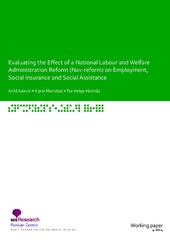| dc.description.abstract | A national labour and welfare administration reform (NAV reform) is evaluated on employment outcomes and use of social insurance and assistance schemes. The reform was implemented step-wise over time during 2006—2010 at different geographical locations. Thus, we are able to create treatment and control groups to facilitate causal interpretations of the empirical results. We use a data set on individuals where we match local implementation of the reform to individual data on social security, employment, and socioeconomic characteristics. The labour and welfare administration was until 2006 fragmented, involving three large public agencies (employment, social assistance, and social insurance services), with limited coordination and collaborations. The reform merged these institutions into a new organization called NAV, after the “one door for all” principle (“one-stop-centres”). The idea was to help users get faster back to work after a period of sickness or unemployment through coordinated help by generalist case worker competence. We find that this was not the case for the implementation year and the following years, and that the reform failed to reap the intended benefits of the merger process, at least in the short term. This could be due to the fact that most users still demand specialized case worker competence, inadequate planning of IT infrastructure, large training requirements of staff, increased number of users during the 2008 financial crisis, and the buildup of new specialized teams in 2008 that took competent workers away from the day-to-day operation of the new NAV organization. Large bureaucratic organizational reforms can take many years to implement after a turbulent implementation face, and can have short term costs for users. The turbulence of the reform was not fully anticipated even though 25 offices in different municipalities and city districts participated in a pilot project 6 months before the country-wide implementation process started. | en_US |
